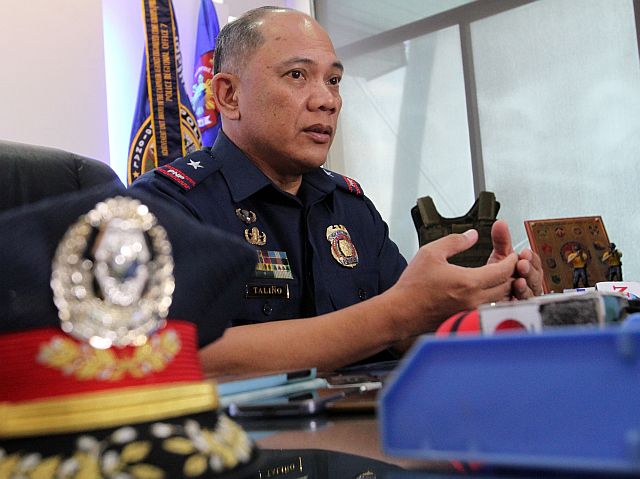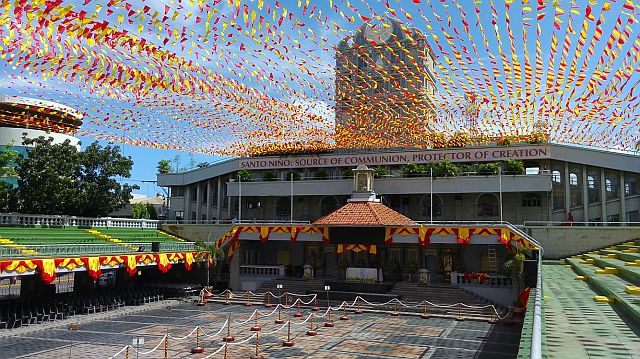
Sinulog, Cebu’s most anticipated event of the year, brings in throngs of foreign and local tourists all wanting to take part in the festivities. Adding color to the celebration are dozens of arches such as this one by Bambi Edible Oil which line the streets during the week. (CDN PHOTO/TONEE DESPOJO)
Police and military personnel are amping up security for Santo Niño devotees and Sinulog revelers to avoid a repeat of a bombing incident which happened in Cebu’s neighboring province of Leyte during a fiesta in Hilongos town.
Chief Supt. Noli Taliño, director of the Police Regional Office in Central Visayas (PRO-7), said about 5,000 law enforcers will secure the Basilica Minore del Sto. Niño in downtown Cebu City and other places of convergence, including the procession and parade routes.
The number of security guards at the centuries-old church was also increased from 65 to 95, while K9 dogs will help monitor the basilica complex.
“The security plan (for the Fiesta Señor and the Sinulog) is in place,” he said during a joint press conference with the Augustinian priests at the basilica’s Aula Magna Tuesday morning.
Taliño discouraged devotees from bringing backpacks and to instead use transparent bags for security personnel to easily inspect their belongings.
For now, he said they have not received any “direct and specific threats” to Cebu and other parts of Central Visayas.
“But I call on the public to be vigilant and alert. If you notice any unusual activity or suspicious-looking persons, please immediately report them to the police,” said Taliño who is closely collaborating with the Armed Forces’ Central Command in ensuring peace and order during the Fiesta Señor celebration.
At City Hall, Mayor Tomas Osmeña advised the public to be aware of their surroundings as he considers the Hilongos bombing as a very big threat to the Sinulog festivity. The blast which injured 32 persons, including ten children, came from an improvised explosive device (IED).
“The nature of IEDs is that they will leave an innocent-looking something on the streets or on the sidewalk. It might be a kariton, a paper bag, a garbage bag. It might be anything that will not arise suspicion,” the mayor said. Several volunteers will be assigned to monitor sections of the streets, Osmeña added.
“When we say, ‘Watch the street,’ it does not mean, watch the people. You have to know what is on the street and just keep looking at it, and if you see a garbage can that was not there five minutes ago, that is what we are looking for,” Osmeña explained.
Osmeña planned to set up a signal-jamming device at the Sinulog grandstand to make the area a dead spot as many bombs are activated through mobile phones. The mayor is awaiting a response from the national government on requests for new police equipment which, he said, he had sent out last year.

TALIÑO
Special gun ban?
Security concerns have been raised after the Hilongos explosion last Dec. 28 and earlier rumors of bomb threats spread all over Cebu last Nov. 4.
But Taliño was quick to allay worries, saying the police and military are on top of the situation.
“We have enhanced police visibility. Our policemen are all over the place. If you need assistance, please approach them,” he said.
The PRO-7 director has requested Philippine National Police (PNP) chief Director General Ronald “Bato” Dela Rosa to allow the implementation of a special gun ban in Metro Cebu until the end of January for the Fiesta Señor activities as well as the Miss Universe pageant’s swimwear presentation in Lapu-Lapu City on January 17.
Taliño has yet to receive a response from Camp Crame.
Millions of people, both local and foreign, are expected to join the religious activities and the Sinulog festival in honor of the Sto. Niño.
‘Walk with Jesus’
The 452nd Fiesta Señor celebration officially starts on Thursday, January 5, with the annual “Walk with Jesus”, a penitential foot procession from Fuente Osmeña to the basilica at 4:30 a.m.
The two-kilometer walk is expected to draw thousands of devotees.
Fr. Pacifico “Jun” Nohara Jr., OSA, the rector of the Basilica del Sto. Niño, will preside over the first novena Mass at 5:30 a.m. at the Pilgrim Center where this year’s fiesta Hermano and Hermana Mayores, businessman Leo Manguilimotan and wife Cristina, owners of Arbee’s Bakeshop, will be installed.
The theme for this year’s feast is “Santo Niño: Source of Communion, Protector of Creation” which is patterned to the pastoral thrust of the Catholic Bishops’ Conference of the Philippines on the Year of the Parish, and Pope Francis’ encyclical “Laudato Si” on the care of the environment.
Laudato Si means “Praise be to you” which is the first line of a canticle by St. Francis that praises God with all of His creation.
“In a world full of strife, war, and division, our faith in the Sto. Niño will hold us together. Let us pray for peace in our beloved country and in our families. The Sto. Niño is the source of communion,” said Nohara, a native of Pilar town, Camotes Islands in Cebu, who is on his first year as rector of the basilica.
In reference to the environmental aspect of the theme, Nohara called on the faithful to take care of everything God has entrusted to them.
“As you see, the image of the Sto. Niño holds the world in His hands. He protects everything in the world. Let us also do our part to save creation. If we threaten the environment, it will also threaten us,” he said.

The Basilica Minore del Sto. Niño in downtown Cebu City will be open 24 hours a day to welcome pilgrims starting January 5 until the feast day on Jan. 15. (CDN PHOTO/ADOR VINCENT S. MAYOL)
Basilica open 24 hours
To accommodate throngs of devotees, Nohara said the basilica will be open 24 hours a day starting January 5 until the feast day on Jan. 15.
At least eight large LED screens and several television monitors are mounted inside and outside the church for people to view the Mass.
Communion kiosks have also been installed in the church yard and in the adjoining streets.
Lay ministers will be stationed there to distribute sacred hosts during Holy Communion so devotees don’t have to crowd into the Pilgrim Center.
Red and yellow umbrellas for devotees are also available at the church but these have to be returned after use.
Except on January 5 and 13 when there are dawn processions, 11 Masses will be held at the outdoor Pilgrim Center every day leading to the feast of the Sto. Niño.
The schedules are 4 a.m. (except on Jan. 5 and 13), 5:30 a.m., 7 a.m., 8:30 a.m., 10:00 a.m., 11:30 a.m., 1 p.m., 2:30 p.m., 4 p.m., 5:30 p.m., and 7 p.m.
Stop bringing balloons
The Augustinian fathers, the caretakers of the basilica and the Sto. Niño image given as baptismal gift by Portuguese explorer Ferdinand Magellan to Cebu’s Queen Juana in 1521, appealed to devotees to stop the colorful practice of releasing balloons, with prayers written on slips tied to the tails.
“I request everyone to stop bringing balloons at the basilica as well as during the solemn processions because these materials are hazards to the environment,” said Fr. Aladdin Luzon, who heads the committee on security of the Fiesta Señor.
In 2014, the Augustinians prohibited the sale of balloons at the church compound during the Fiesta Señor celebration in response to the call of environment advocates who said balloons that end up in the sea are eaten by marine animals like whales and dolphins, which mistake them for food.
The synthetic material ends up in their stomachs undigested, causing the animals’ death.
Also, balloons released into the air can cause power interruptions, Fr. Luzon said.

SINULOG 2011 FLUVIAL PARADE/JAN.15,2011:Devotees of the Snr Sto Niño wave their hands as the image pass them to board the Galleon to transport from Mandaue City Ouano wharf to Cebu City Port during the Sinulog 2011 fluvial parade.(CDN PHOTO/LITO TECSON)
In 2013, a power transformer exploded along M.J. Cuenco Avenue when it was hit by a flying balloon during the solemn procession. It caused a temporary power outage.
For several years, the release of balloons in the air during the feast of the Sto. Niño has been a popular gesture of lifting prayers to heaven.
The Augustinian fathers want the practice to stop, teaching devotees the proper way of expressing their faith.
Solemn activities
On Jan. 13, another dawn procession will bring the image of the Our Lady of Guadalupe de Cebu from Fuente Osmeña to the basilica in the annual “Walk with Mary.”
After the 5:30 a.m. Mass at the basilica, the images of the Sto. Niño and the Our Lady of Guadalupe de Cebu will be brought in a motorcade to the National Shrine of St. Joseph in Mandaue City.
This year’s traslacion will pass by MJ Cuenco Avenue straight to the national highway of Mandaue City, right turn to A. Del Rosario Street, and right to Sotero B. Cabahug Street going to St. Joseph’s Shrine.
The annual “traslacion,” a Spanish word which means “to transfer or move”, depicts the “reunion” of the Holy Family — the Child Jesus, his mother Mary, and foster father Joseph.
On the following day, Jan. 14, the image of the Sto. Niño and the Our Lady of Guadalupe will sail down the Mactan Channel on board a yacht for the fluvial procession that will start at 6 a.m. from the Ouano Wharf in Mandaue City to Pier 1 in Cebu City.
A foot procession from Pier 1 will bring the images back to the basilica where the reenactment of the first Mass, baptism, and wedding will be held.
In the afternoon, the grand solemn procession of the Sto. Niño will be held along the major thoroughfares of the city.
The 5.8-kilometer prayer walk will start at 1:30 p.m.
From the basilica, the carrozas of St. Joseph, Our Lady of Consolation, and the Sto. Niño de Cebu will pass along Osmeña Boulevard.
Upon reaching the Fuente Osmeña circle, the procession will proceed to General Maxilom Avenue, Imus Street, MJ Cuenco Avenue, Urdaneta Street, P. Burgos Street, and back to the basilica.
A Mass will be celebrated by Palo Archbishop John Du at 6 p.m. to be followed by an hour-long traditional religious Sinulog to the beat of the drums.
On Sunday, Jan. 15, the feast day of the Sto. Niño, Cebu Archbishop Jose Palma will officiate a pontifical Mass at 6 a.m. to be followed by eight other Masses.
Disclaimer: The comments uploaded on this site do not necessarily represent or reflect the views of management and owner of Cebudailynews. We reserve the right to exclude comments that we deem to be inconsistent with our editorial standards.
